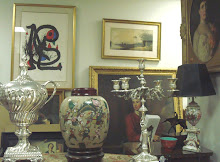 Everyday art appraisers examine a variety of objects from a variety of time periods and genres. From an appraiser's unbiased point of view, it is more important to understand a particular genre and not whether or not it fits your particular taste. Although I greatly enjoy modernist pieces, I understand that not everyone is of a similar mindset. Therefore, I would like to visually examine a notable piece of modernist sculpture, discuss the possible creative philosophies of the artist who made it, and explain why I appreciate it.
Everyday art appraisers examine a variety of objects from a variety of time periods and genres. From an appraiser's unbiased point of view, it is more important to understand a particular genre and not whether or not it fits your particular taste. Although I greatly enjoy modernist pieces, I understand that not everyone is of a similar mindset. Therefore, I would like to visually examine a notable piece of modernist sculpture, discuss the possible creative philosophies of the artist who made it, and explain why I appreciate it.The above sculpture, currently at MIR Appraisal Services, Inc., was created by Ruth Duckworth. She was born in Hamburg Germany in 1919, but fled Nazi Germany for England at the age of 17. Duckworth began her formal art training at the Liverpool School of Art, then studied at the Hammersmith School of Art, and finally went to the Central School of Arts and Crafts in London. Eventually Duckworth would move to Chicago to teach at the University of Chicago, which she did until 1977. She is known to still live in the Chicago and continues to sculpt.
Beyond the facts of Duckworth’s life, what I find interesting about her work is that she produces pieces that are entirely unique to both the art world and to the broader genre of everyday objects. What I mean by this is that her work is removed from common visual forms and preconceived notions of what a ceramic, bronze, or clay object is suppose to look like. Instead Duckworth’s sculptures only attempt to be just what they are, nothing more. In her work, she does not attempt to depict people, animals or bowls; they simply are what they are, art objects. Furthermore, what makes Duckworth’s sculptures interesting is that they are unique extensions of the artist herself. Meaning that although Duckworth has gone through many creative phases processes, in which she has used varied materials, the underlying tie that binds her creativity, appears to be the organic creation of her pieces. In the artists own words “I don’t want to think. I want it to happen by itself, to flow up.” She is creating works that for the first time exist in the world through her intuitive feel for the materials she uses.
The Duckworth sculpture, currently at MIR Appraisal Services, Inc. is an example of the organic creative methods that the artist uses. This ceramic stone ware and mixed media work consists of two long and rounded pieces in the center that converge at one side, but remain open at the other end. Each extremity emerging from the central torso has been extended gracefully by the artist, so that there is a seamless flow throughout the work's entirety. This particular sculpture is a fine example and testament to Ruth Duckworth's creative philosophy with its unique appearance and organically sculpted limbs.
For more information or acquisition inquiries on this newly restored Ruth Duckworth sculpture, please contact MIR Appraisal Services, Inc. in Chicago at (312) 814-8510 or email us at mirappraisal@aol.com.
-MIR Appraisal Services, Inc.
Resources Consulted & Further Reading:
Hales, Linda.”Ruth Duckworth: Modernist Sculptor.”Washington Post (Sept. 4, 2006): C01, http://www.washingtonpost.com/gog/exhibits/ruth-duckworth-modernist-sculptor,1127401.html
Stair, Julian.“Duckworth’s volumes and planes: a traveling retrospective examines the 60-year career of sculptor Ruth Duckworth, whose reductive vessels and blocky figures reflect the coolness of international modernism.”Art in America (Dec., 2005), http://findarticles.com/p/articles/mi_m1248/is_11_93/ai_n15979877





 Traditional Inuit life involved survival in a semi-nomadic society where men hunted and women tended to life at the camp. It has been noted that the Inuit lived in houses made of snow known commonly as igloos and hunted seals and whales, using their skins in order to make warm clothing and footwear. For entertainment the Inuit people told stories (which are greatly reflected in their visual arts), wrestled and played various hand and eye coordination type games in addition to singing and dancing. Additionally, Shamans were prevalent to traditional Inuit culture, serving as a link to the spiritual world. Shamans as well as ordinary tribesmen wore charms and amulets that were believed to be magical.
Traditional Inuit life involved survival in a semi-nomadic society where men hunted and women tended to life at the camp. It has been noted that the Inuit lived in houses made of snow known commonly as igloos and hunted seals and whales, using their skins in order to make warm clothing and footwear. For entertainment the Inuit people told stories (which are greatly reflected in their visual arts), wrestled and played various hand and eye coordination type games in addition to singing and dancing. Additionally, Shamans were prevalent to traditional Inuit culture, serving as a link to the spiritual world. Shamans as well as ordinary tribesmen wore charms and amulets that were believed to be magical.





